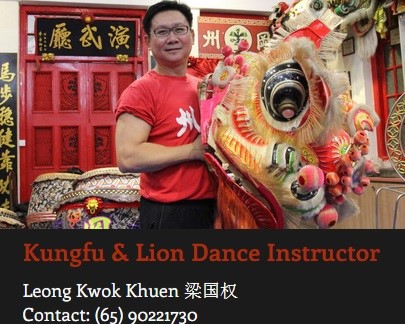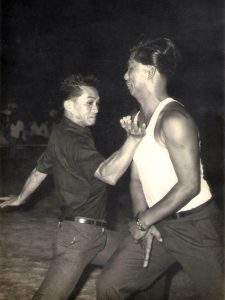Philosophy 理念
“练功练得法,收获成就大”
Progressing on the correct track of combat science will bring you great knowledge leading to great accomplishment.
Value 价值观
饮水思源
Remembering your roots
自强不息
Continuous self-improvement
继往开来
Take what our forebears have left us but as a departure for new inventions
以和为贵
Harmony as virtue
Our Lineage
Old Kong Chow (currently known as Jiangmen Xinhui, China) was the hometown of many well-known Kungfu masters. For instance, famous Hung Gar expert Master Wong Fei Hung (1847 – 1924) was born in Xiqiao, Guangdong; Master Chan Heung who founded Choy Lee Fut martial arts in 1836 by synthesizing the
essence Choy Gar , Lee Gar and Fut Gar styles was also from Xinhui, Guangdong; The popular Chou Gar Kungfu was created by the eldest of the five Chou brothers from Xinhui Tangxia, Guangdong (known as “Five Tigers of Chou Gar”), who incorporated the muscular and mighty movements of Hung Gar and the swift footwork and complex kicking of Choy Gar; Grandmaster of Wing Chun kungfu, Leung Jan ( 1826 一 1901)whose real name was Leung Dak Wing, is also known as Mr Jan from Foshan.
Kong Chow ancestors taught Hung Gar, Choy Lei Fut, Wing Chun, Hung Choy and Chou Gar Kung Fu in the early days. Hung Gar is especially prevalent in Singapore Kong Chow Wui Koon today.
Hung Kuen (洪 拳)’s roots date back to the 17th century Southern Shaolin Temple in FuJian. As the Shao Lin monastery was the core of the pro-Ming anti-Qing movement, the Qing government burned down the monastery in the 18th century. One of the Shao Lin Disciples Hung Hei Goon fled to Guangdong and promoted Hung Kuen there. Hung Kuen is the most famous and respected among five noted families of Kung Fu from Southern China – namely, Hung Gar ( 洪 家 ), Choy Gar (蔡 家), Lau Gar (刘 家), Lee Gar (李 家), and Mok Gar (莫 家). Hung Kuen’s most well-known traits are firm stances and forearm strikes with short powerful movements that combine both attack and defense.
Wong Fei Hung (1847 – 1924), one of the best known Chinese martial artists in modern times, was an expert in the Hung Kuen style. Wong Fei Hung has eight close disciples, two of which are Lin Wan Kai and Lam Sai Wing. Hung Gar in Singapore Kong Chow Wui Koon benefits from a dual-lineage that can be traced back to these two grandmasters.

Kungfu Curriculum
“Kungfu is a fight science: do not follow blindly, you have to experiment and test it yourself.”
“Kung Fu” is the word largely used to describe Chinese martial art skill. It was developed by our great ancestors who fought hard to protect their families & country.
Unfortunately, there isn’t any platform developed that allows us to effectively practice & exchange appropriate applications documented by our past Sifus. Therefore, Traditional Chinese combat techniques are slowing losing its shine compared to other combat skills which are highly applicable in many fight sports events today.
In Singapore Kong Chow Wui Koon’s marital art training, we not only pay a lot of attention on the foundation training, we have also developed an effective platform to address the issue mentioned above. It’s called “ 散手对练” Empty hands exchange (Not to be mistaken with Sanda/Free Sparring).
Primary drills with be taught to beginners before they can develop learning skills to train with other fellow practitioners. This is done under tight guidance by our senior coach so as to avoid any training injuries.
基本马步
Foundational Horse Stances
四平大马
三角马
前弓后顶马
子午马
吊马
消身走马
麒麟马
盘龙脚步
蹴脚
穿心脚
铲脚步
拐脚步
标坎马步
拳套路
Fist Forms
洪家套路:
Hung Gar Fist Forms:
工字伏虎拳
Taming the Tiger Fist
虎鹤双形拳
Tiger Crane Paired Form Fist
五形拳
Five Animal Fist
铁线长桥拳
Iron Wire Fist
十字拳
Ten Character Fist
五行拳
Five Element Fist
其他拳路:
Other Fist Forms:
快手洪拳
Quick-hand Hung Kuen
蔡李佛拳
Choi Let Fut Fist
海南拳
Hainan Fist
蛇貓鶴混形拳
Snake, Cat, Crane Mixed Form Fist
罗汉拳
Arhat Fist
奔步螳螂拳
Praying Mantis Fist
兵器套路
Weapon Forms
双匕首
Double Dagger
少林单刀
Shaolin Broad Sword
藤牌刀
Shield Broad Sword
单刀鞭
Broad Sword Whip
虎翼双手刀
Double-hand Sword
滚地堂双刀
Double Broad Sword
子母双刀
Mother & Son Butterfly Swords
凤凰剑
Pheonix Sword
穿云伞
Umbrella
双头棍
Double-head Pole
五郎八卦棍
Fifth Brother Eight Trigram Pole
周家十字单头棍
Chou Gar Ten Character Pole
锁喉枪
Throat-piercing Spear
吕布戟
Lü Bu Halberd
姚家大扒
Yao Gar Trident
春秋大刀
Spring-Autumn Long Broadsword
鼠尾棍
Rat-tail Long Pole
三节棍
Three-section Staff
双钩
Double Hook
双鞭
Double Whip
伏虎铜锤
Taming the Tiger Bronze Hammer
长凳
Long Bench
对拆/ 散手
Sparring/ Sanshou
徒手/兵器对拆
Fist/Weapon Choreographed Sparring
徒手对拆
Empty Hand Sparring
藤牌刀对三节棍
Shield Broad Sword vs Three-section Staff
双刀对枪
Double Broad Sword vs Spear
双头棍对拆
Double-head Pole Sparring
双头棍对凳
Double-head Pole vs Long Bench
洪家散手
Hung Gar Sanshou
Lion & Dragon Dance Curriculum
“Agile movements are achieved through hardship and perseverance, stable horse stances rely on real Kungfu.”
The Cantonese Foshan Lion (粤狮) is the representative of all Southern Lions. Cantonese lion dancing attaches importance to horse stances and various martial arts techniques as its foundations. To perform a traditional lion dance for more than thirty-minutes is a true test of a practitioner’s kungfu. The most outstanding Hung Gar Lion Dance Master in history is none other than “Foshan Lion King” Grandmaster Wong Fei Hong.
Traditional lion dance almost always has the “plucking the green” component (采青). The origin of plucking the green can be traced back to the civilian anti-Qing movement. In order to disguise their anti-Qing cause, they use the phonetic similarity between “plucking the green” (“采青”) and “trampling the Qing” (“踩清”) to belittle the Qing government. Likewise, the lion dance routine of “swallowing the green” (“吞青”) signifies “overthrowing the Qing Dynasty” (“吞灭清朝”), and the routine of “throwing out the green” (“吐青”) is a metaphor for “dispersing the Qing government” (“散清”). As this art is passed down over the generations, other elements, such as “stories” and “good fortune”, were included in the plucking green themes, leading to the rich traditional green formation culture we see today. To successfully overcome green formations is a test of the wisdom and skills of the lion dancers.
It is said that Xinhui’s dragon dance has a history of a thousand years. It evolved from straw dragon to fire dragon, fabric dragon and gauze dragon. The gauze dragon of Xinhui’s Chao Lian and He Tang also has a history of more than 800 years. Its unique feature is to place candles in the dragon’s body to create a spectacular sight of a blinking gauze dragon in movement at night.
Kong Chow Wui Koon’s Dragon Dance Troupe was formed in 1980 and has since performed various types of dragons created in-house, including huge silver dragon, golden dragon, gauze dragon and fire dragon, at major events (e.g., Chingay street parade and River Hongbao).
基本马步
Foundational Horse Stances
四平大马
三角马
前弓后顶马
子午马
吊马
消身走马
麒麟马
盘龙脚步
蹴脚
穿心脚
铲脚步
拐脚步
标坎马步
乐器
Musical Instruments
鼓
Drumming
锣
Gong
拔
Cymbols
步
青阵
Green Formations
座两星,过三山,碎灵芝
On two stars, cross three mountain, crush the Lingzhi
生蟹青
Live Crabs Qing
水龙青
Water Dragon Qing
兵器青
Weapons Qing
高青
High Element Qing
硬破水缸阵
Breaking the large ceramic pot
七星伴月
Seven stars surround the moon
降龙阵
Conquering the Dragon Qing
叠罗汉高青
Human Pyramid High-Element Qing
醉狮
Drunken Lion
三人高青
Three Men High-Element Qing
Kungfu Practice Timings
–Call for update
Lion & Dragon DancePractice Timings
Saturday (8pm-10pm)





































